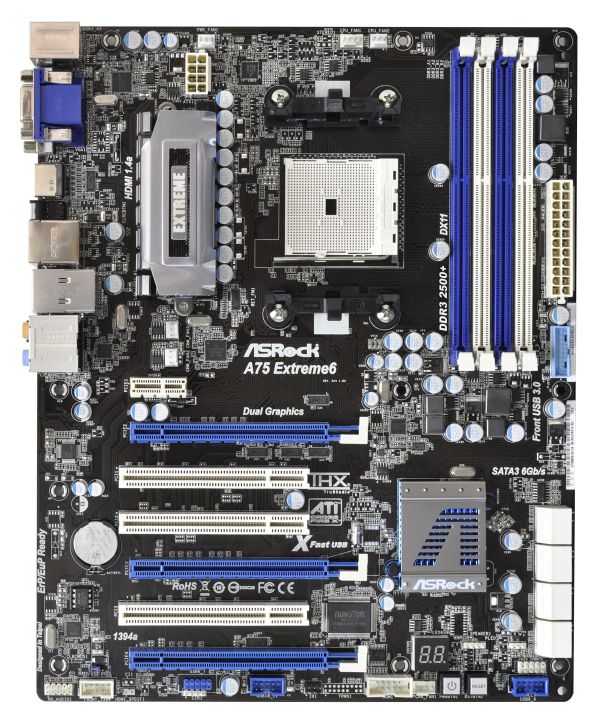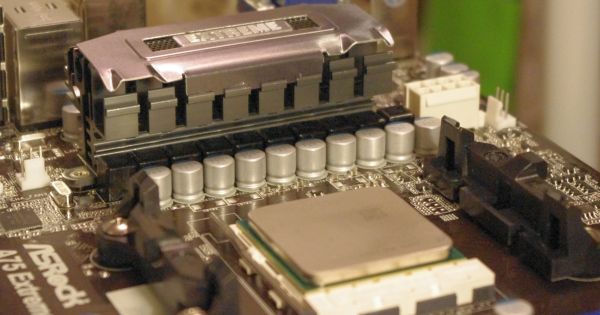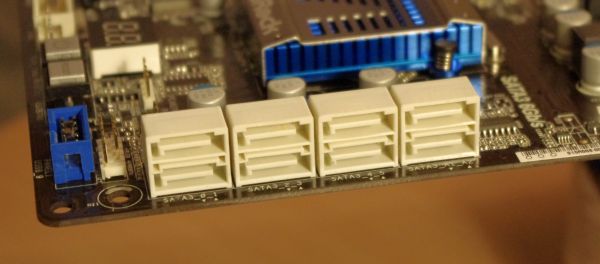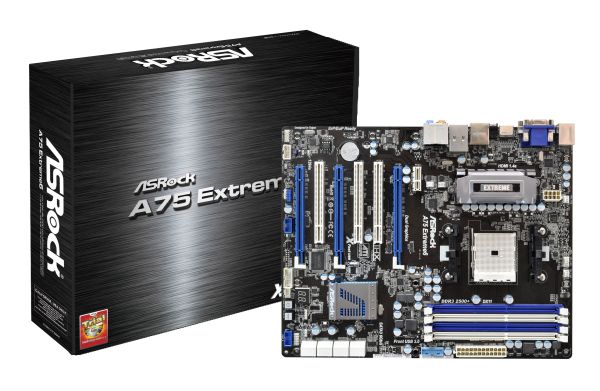ASRock A75 Extreme6 Review and Desktop Llano Overclocking
by Ian Cutress on June 30, 2011 12:05 AM ESTOur initial tests with the ASRock A75 Extreme6 were based on a pre-release model, and shown in our preview. At that point, the board design was not finalized and the BIOS was still quite raw, but the performance was essentially complete. However, now in my grasp is the full release version of the Extreme6. Alongside this standard motherboard review, and testing to see whether it's worth the $150 asking price, we're also going to take a good look at the overclocking features of the Desktop Llano chipset.
I've essentially run our motherboard test suite on two versions of this board now, and having recently played with Cougar Point and AMD Fusion (review to come), it slots nicely in the middle in most aspects - especially CPU power. We're not seeing anything special here with Desktop Llano - as Anand pointed out, in the region of Phenom II X4 performance. For the integrated GPU, it's a different matter, with up to 2x the performance of the highest version of Intel's integrated graphic solutions of the Sandy Bridge second generation Core series. Both of these will come in the form of results I will look at later.
Overview
The ASRock A75 Extreme6 is aimed at the high end Desktop Llano workspace, and, from what ASRock are telling me, will ship in at $150. Unfortunately, I haven't other A75 boards to compare it to yet, but I get the same steady feeling I've got from ASRock boards of late - it's just something that works. There's one minor glitch for now that I've found, to do with memory compatibility, but what we're dealing with here on the board is a good number of features, and the only real downside is the Llano chip itself.
If we look at the prices of the 890 chipset, most motherboards are in the $100-$145 range, so in terms of CPU performance, we're paying a little extra. With the integrated APU at hand, however, you could see where the extra comes from - a different power integration arrangement, and the need for various video output connectors. Personally, I see Desktop Llano more of a niche area, so it will be interesting to see how aggressive the motherboard manufacturers are with pricing.
Visual Inspection
Desktop Llano features the same retention bracket spacing as AM2 and AM3, which, in all honesty, is quite big compared to Intel's chipsets. As a result, we see a bunched up power delivery to the west of the socket itself, covered in a large heatsink of ASRock's design (this is a main difference to the preview board I tested earlier). The chokes on this design are still of the old design - if you can recall, during my tour with ASRock at Computex, I noticed they were using a different choke design on their high end boards to improve power delivery, heat generation and efficiency (similar to MSI's SFC). It seems that the new design still hasn't filtered down into their non-gaming products; despite the fact that I was told that the two choke designs cost the same.
The socket area itself has five fan headers, of which I highly approve and would like to see on every other motherboard on the market - I'm using a Corsair H50, which in dual fan mode requires three (two for fans, one for the pump), so having another couple at hand for case fans is always a plus. Two of the fan headers are labelled for the CPU (one four pin, one three pin), the two under the power delivery are chassis headers (both three pin), and the one above the power delivery is a PWR fan (again, three pin). Elsewhere on the board is one more fan header, labelled as chassis (another three pin).
Beyond the 24-pin ATX connector is a USB 3.0 header, but unfortunately no USB 3.0 bracket comes with this ASRock board like their Sandy Bridge Extreme series. The eight (yes, eight) SATA 6 Gb/s ports come in a couple of flavors - six from the Fusion Controller Hub (FCH), and two more from an ASMedia controller. We also see the Power/Reset/Debug LED combo, which I approve of.
The FCH heatsink is ASRock's low profile, silent design, which actually gets quite warm when anything is overclocked. PCIe design is x1, x16, PCI, PCI, x16, PCI, x4 - with the x16 slots running at x8/x8 mode when two discrete GPUs are being used.
The I/O panel is actually fairly bare, as ASRock haven't decided to stack anything on top of the HDMI. With some extra effort, I'm sure a pair of USBs could be stacked on top of it. Actually, in my initial preview piece, I stated how the USB ports on the far left (physically at the top of the board) were quite tough to get anything in beyond a USB mouse or keyboard if the DVI video out was used. ASRock's response was to 'use a USB port extender - we had to cater for those using DVI + HDMI at the same time', which in my eyes is a stone's throw away from 'oops, we didn't spot that'. Other connectivity comes in the form of a PS/2 port, two native USB 3.0 ports, two USB 3.0 ports from an ASMedia ASM1042 controller, a VGA port, two USB 2.0 ports, an eSATA 3 Gbps port, Realtek controller enabled gigabit Ethernet, a Firewire port, an optical SPDIF out, and the standard audio outputs.















44 Comments
View All Comments
mino - Thursday, June 30, 2011 - link
"The question now becomes, is Desktop Llano worth the extra $75?"I keep wondering how much it cost to get you to claim Llano is 1/3 more expensive that i3 ?
REALLY ???
1) I do not remember you comparing _whole_platform_cost_ when reviewing Intel chips against AMD, at a time when there was a $30 Intel mobo tax in place.
2) Taking one of the highest-end Llano mobos with the highest-end Llano chip and comparing it price-wise to lowest-end SB (which it thoroughly trounces in everything besides single-threaded pure CPU loads) coupled to a low-end SB mobo? REALLY?
Shame.
L. - Thursday, June 30, 2011 - link
Eh .. sometimes bias is so visible, I'm not the only one to react anymore ;)But they do it every day... if anyone remembers the Xeon e7 review, where AT clearly showed that a 45nm Opteron was better in perf/watt than a 32nm Xeon ... biggest fail ever on the part of Intel that (they had same efficiency within 2% at full load, but reality is not full load :p ).
Even Tom's Hardware, which was Intel sponsored since the day it was sold wasn't even half as hard on the Llano as you guys ....
The one good info anyone can get out of this is that Intel is afraid of Llano and they're ready to pay a lot to get it slandered... one more reason to buy it, if Intel thinks it's great :)
whatthehey - Saturday, July 2, 2011 - link
No, you're not the only one to "react". You and all your asshole AMD luvin' fanboys from AMD zone or wherever are all over every one of the recent AMD articles on this site. Llano is an inexpensive APU that fails to impress. It's not bad, but for what it delivers? PLEASE!Overclocking? Intel wins by such a huge margin it doesn't even matter.
HTPC? Llano is buggy right now. Your best bet is a discrete GPU for serious HTPC use, and as long as you're getting a discrete GPU, you should buy the better CPU to go with it. Guess what, Intel wins again.
Gaming? Get a fucking clue, L. and duploxx. AMD has some great GPUs, but Llano is barely good for entry level gaming. No one that really cares about gaming is going to be impressed by something that matches a $35 dGPU.
General performance? Intel wins. Doesn't matter if it's SYSmark, PCMark, Sunspider, or some other test -- Intel has a substantially faster CPU architecture.
Pricing? Right now, AMD even loses this. Sure, you can get AMD systems for less than Intel systems, like if you get last-gen AMD. The Llano stuff right now is too expensive on the motherboard side to beat Core i3 and Pentium. When motherboard production ramps up, AMD and Intel will still be very nearly tied on pricing for low-end parts. Hooray!
3DMark. AMD wins in the IGP battle! Who cares about 3DMark? L. and duploxx and a bunch of other retarded AMD bigots who drink the AMD kool-aid and quote AMD PR like a bible.
In summary: everyone with half a brain can see the AMD Llano articles at Anandtech for what they are: factual representations of performance showing that AMD only wins on graphics, and only against IGP. Llano is only going to impress the dimwitted folks that slobber over every AMD release. Those who look for the best system will stay away, but I'm sure Best Buy will sell lots of these Llano systems to people that really have no idea what hardware is inside and don't care one way or another.
Snotling - Thursday, June 30, 2011 - link
"Tomorrow's technology today" they say... Seing as the Board has 3 "legacy" oh, no let me use "outmoded" PCI slots, I would call that "Yesterday's technology in store tomorrow"Who ever needs more than 1 PCI slot anymore? I can easily live with NONE.
But still they keep on designing boards with 2 and 3 of those... try finding a board with a 4x or 8x PCI-E for a RAID Add-on, almost non-existent unless you go for a server board.
This is supposed to be a higher end product for enthusiasts and I'm really NOT enthusiastic about NOT having a PCI-E 4x expansion on it.
dczyz - Thursday, June 30, 2011 - link
Just picked up a ASUS P8Z68-V PRO and was very disappointed with the lack of support for the Server 2008 based OS's.Since Server 08 is being used in Home Server, and Small Business I would like to see motherboard reviews cover compatibility for that.
mino - Thursday, June 30, 2011 - link
Server 2008 R2 is Windows 7 driver-wise. What more "compatibility" do you want?NOBODY is going to do server OS validation for you on desktop platforms for free. If you need that, go for a proper WS board.
Meaker10 - Friday, July 1, 2011 - link
So again you acknowledge the NB frequency option but ignore it?No look at if this helps performance?
enterco - Saturday, July 2, 2011 - link
The way see it, AMD Llano, used without a discrete GPU, is a good start-up platform for- multimedia management: USB3, SATA3 and quad core are strong points, enabling light video encoding tasks
- a kid's PC, who does not play yet 3D shooters.
Somewhere in this article I saw: "Metro 2033 is the Crysis of the DirectX 11 world (or at least until Crysis 2 is released)"
Ummm.... Crysis 2 sold here is not DX11 capable ? http://www.amazon.de/Crysis-2-Limited-Edition-uncu...
puretech - Saturday, July 2, 2011 - link
"with up to 2x the performance of the highest version of Intel's integrated graphic solutions of the Sandy Bridge second generation Core series."A very statement statement considering all tests last two days show 2 - 6 times higher performance, with drivers and programs (and BIOS) yet to be tuned for the Fusion platform.
whatthehey - Sunday, July 3, 2011 - link
Horse shit. What is it with all the AMD crazies? Llano's IGP is on average about twice as fast as HD 3000, unless you test with a few specific games. Anything OpenGL pretty much tanks on Intel, but the number of current OpenGL titles that people play is quite small... Minecraft is probably the best example. Let's take a few of the major sites.Tom's Hardware:
Metro 2033: Llano is about 2x faster than HD 3000
Call of Duty Modern Warfare 2: Llano is twice as fast, give or take (depending on settings)
World of Warcraft: Llano is twice as fast, give or take.
AnandTech:
Crysis: Warhead: Llano is about twice as fast
Metro 2033: Less than twice as fast
HAWX: Less than twice as fast
Civilization V: About three times as fast (one of the few cases where we see more than a 2x increase)
DiRT 2: About 2.5x as fast
Mass Effect 2: Less than twice as fast
StarCraft II: usually less than twice as fast
Legit Reviews:
Resident Evil 5: Less than twice as fast
HAWX 2: about 2.5x as fast
STALKER Call of Pripyat: about twice as fast
PC Perspective:
Civ V: Tied with the HD 3000 in the i7-2600K
DiRT 3: about 2.5x compared to HD 2000
Left 4 Dead 2: Less than twice as fast
StarCraft II: about 2x
So that's four major sites and the highest lead by Llano in graphics is only 3x -- nowhere near the 6x you claim. On average, 2x lead compared to the i3-2105 looks about right, and if you put in an HD 6670 -- which is really the bare minimum for anyone that actually wants to play games -- you get double the performance of Llano. OMFG! That's amazing! Let's all praise AMD for delivering an IGP that can perform half as fast as what mainstream gaming actually needs!
GTFO. I'm sick of all the AMD crybabies. Llano is mediocre on desktops at best. It's better on a laptop, but only for medium detail 720p gaming. To pretend that medium detail 720p is more important than all the other aspects is stupid. But then, no one ever said fanboys were smart.